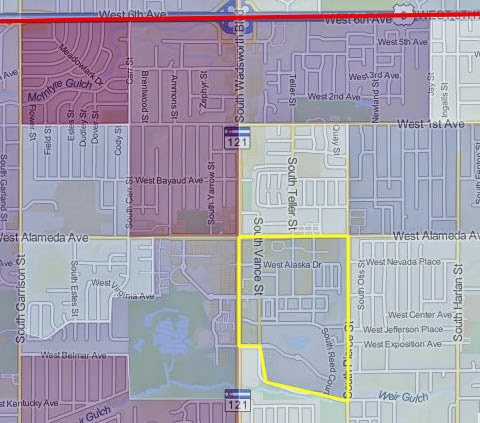But who lives in downtown Lakewood? What is the character of these quadrants? To get some hard data, I took a look at the 2010 census data for Lakewood, which is broken down by census tract. These census tracts roughly-- though not exactly-- line up with the boundaries of what the city considers to be its official downtown.
Northwest Quadrant
Let's start with the Northwest Quadrant. This is the area behind the Olive Garden and Dairy Queen that you see on the corner of Wadsworth and Alameda. It's a mostly residential area of 1950s and 60s ranch homes with large yards, along with a smattering of newer construction. There's also a fair amount of undeveloped land in this quadrant, including the large parcel where the Villas at Belmar is planned.
1168 people lived in this neighborhood as of 2010, and the median yearly income was $80,667. The median age was 45, and the poverty rate was just 2.7%. The largest ethnicity in the Northeast Quadrant was Non-Hispanic White, at 69%. The next two largest were Hispanic, at 20%, and Asian, at 5%.
 |
| Census Tract Roughly Aligning with Northwest Quadrant of Downtown Lakewood |
Southwest Quadrant
The Southwest Quadrant is the least populated in downtown Lakewood-- not surprisingly, as it's home to the large Belmar Park, as well as the Lakewood civic center. This is where you'll find the Lakewood Heritage Museum, the galleries and performance space of the Lakewood Cultural Center, the headquarters of both the Lakewood police and the West Metro fire department, the city council chambers, and a number of city offices.
I should also note that the Belmar Commons shopping center is located in this quadrant, with a King Soopers as its anchor tenant.
Demographics wise, the Southwest Quadrant (or at least the census tract with which it roughly overlaps) was home to just 717 people as of 2010. The median yearly income was $59,063. The median age was 56.6, and the poverty rate was 11.9%. The largest ethnicity in this Quadrant was Non-Hispanic White at 74%. The next two largest were Hispanic, at 9%, and Multiethnic, also at 9%.
 |
| Census Tract Roughly Aligning with Southwest Quadrant of Downtown Lakewood |
Northeast Quadrant
From Alameda and Wadsworth, this quadrant is defined by the new Walgreens and Key Bank buildings, along with a construction zone that is soon to be an emergency medical center.
As you drive further east, you see aging strip malls and rows of fast food restaurants. Behind them is a neighborhood of modest but generally well-maintained homes, along with the green oasis of the Villas, an age-restricted retirement community. In the middle of the neighborhood is Stein Elementary, while the large O'Kane Park sits just to the north.
I have to say that this neighborhood reminds me a lot of Cherry Creek North in the 1980s and early 1990s, when that Denver neighborhood was defined by its modest bungalows and its proximity to the new Cherry Creek shopping center. Today, of course, those bungalows are gone, replaced by high-end infill housing. The extremely modest price of housing in this part of downtown Lakewood, combined with its walkability to Belmar, makes me wonder if we'll see a similar wave of scrape-offs and infill construction in the future. Could it be the next Cherry Creek North?
In terms of the data, this neighborhood was home to 1582 people as of 2010. The median yearly income was just $35,263, but the poverty rate was a low 3.7%. The median age was just 33. The largest ethnicity in this Quadrant was Non-Hispanic White at 58%. The next two largest were Hispanic, at 35%, and Multiethnic, at 2%.
 |
| Census Tract Roughly Aligning with Northeast Quadrant of Downtown Lakewood |
The new urbanist development of Belmar dominates the Southeast Quadrant of downtown Lakewood. It's an area that has seen a complete transformation since the 2000 census, going from a decayed and mostly empty enclosed shopping mall to a traditional urban neighborhood with mid-rise buildings, a street-grid, and mixed residential, commercial, and retail space.
All this development makes this quadrant by far the most populous part of downtown Lakewood. As of 2010, it was home to 3299 people-- a number that will grow in next few years as Metro West Housing Solutions, David Weekley and Holland Partner Group complete their large residential projects. Median incomes was $49,600, and the median age was 29.7. Yes, Belmar is substantially younger than the rest of downtown Lakewood. Interestingly, the poverty rate stood at 11.3%, which goes a bit against Belmar's glossy image-- but there's more affordable apartments and condos on the southern end of the census tract. The largest ethnicity in this Quadrant was Non-Hispanic White at 64%. The next two largest were Hispanic, at 31%, and Asian, at 3%.
 |
| Census Tract Roughly Aligning with Southeast Quadrant of Downtown Lakewood |
So that's my look at the demographics of Lakewood's new downtown. Next up: a look at the area's political leanings.
No comments:
Post a Comment